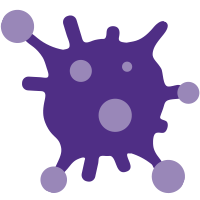
Immunology of Infectious Disease News
Immunology of Infectious Disease News is an online resource dedicated to covering the latest research and developments in the field of infectious diseases.
The Presence of Cytotoxic CD4 and Exhausted-Like CD8+ T-Cells Is a Signature of Active Tuberculosis
[Biochimica Et Biophysica Acta-Molecular Basis Of Disease] Researchers found that lipids from Mycobacterium tuberculosis increased the presence of CD4+ T cells with cytotoxic functions (CD4 CTLs) in DR-TB patients. Our data suggested that active tuberculosis was characterized by exhausted-like CD8+ T cells, which, together with a specific microenvironment, favor the presence of CD4 CTLs.
MR1-Restricted T Cell Clonotypes Are Associated with “Resistance” to Mycobacterium tuberculosis Infection
[JCI Insight] Scientists revealed unexpected donor-specific diversity in the T cell receptor repertoire of human MR1-restricted T (MR1T) cells as well as associations between mycobacteria-reactive MR1T clonotypes and resistance to M. tuberculosis infection.
Therapeutic Vaccines for Herpesviruses
[Journal Of Clinical Investigation] The authors summarize the status of therapeutic vaccines for herpes simplex virus, cytomegalovirus, and Epstein-Barr virus and proposes approaches for future development.
Opportunities and Challenges for T Cell-Based Influenza Vaccines
[Nature Reviews Immunology] Influenza vaccine development has traditionally focused on the induction of protective antibodies, but there is mounting evidence that T cell responses are also protective against influenza. Thus, future vaccines designed to promote both broad T cell effector functions and antibodies may provide enhanced protection.
Recce Pharmaceuticals Reports Positive Preclinical Data of RECCE® 327 in Lung Infection Pilot Study
[Recce Pharmaneuticals, Ltd.] Recce Pharmaceuticals, Ltd.announced positive results from a preclinical pilot study evaluating nebulized RECCE® 327 for the treatment of lung infections in a mouse model.
CRISPR/Cas9 Genome Editing of CCR5 Combined With C46 HIV-1 Fusion Inhibitor for Cellular Resistant to R5 and X4 Tropic HIV-1
[Scientific Reports] Scientists combined an additional anti-HIV-1 therapy, which is C46, a cell membrane-anchored HIV-1 fusion inhibitor with the CRISPR/Cas9 mediated knockout CCR5.
Human CD4+ iNKT Cell Adoptive Immunotherapy Induces Anti-Tumur Responses Against CD1d-Negative EBV-Driven B Lymphoma
[Immunology] Using live cell imaging, researchers found that CD4− iNKT cells limited growth of CD1d+ Epstein–Barr virus (EBV)-infected B-lymphoblastoid spheroids in vitro, whereas CD4+ iNKT cells showed little or no direct anti-tumor activity.
Antiviral, Anti-Inflammatory and Antioxidant Effects of Curcumin and Curcuminoids in SH-SY5Y Cells Infected by SARS-CoV-2
[Scientific Reports] The authors observed that Me23 significantly decreased the expression of plasma membrane-associated transmembrane protease serine 2 (TMPRSS2) and TMPRSS11D, consequently mitigating the elevated ROS levels induced by SARS-CoV-2.
Antigenicity Assessment of SARS-CoV-2 Saltation Variant BA.2.87.1
[Emerging Microbes & Infections] Investigators elucidated the antigenic characteristics and immune evasion capability of BA.2.87.1. Our findings revealed that BA.2.87.1 was more susceptible to XBB-induced humoral immunity compared to JN.1.
Computationally Restoring the Potency of a Clinical Antibody Against Omicron
[Nature] The authors showed that their computationally redesigned antibody, 2130-1-0114-112, simultaneously increased neutralization potency against Delta and subsequent variants of concern, and provides protection in vivo against the strains tested: WA1/2020, BA.1.1 and BA.5.
Neuropathological Assessment of the Olfactory Bulb and Tract in Individuals With COVID-19
[Acta Neuropathologica Communications] Using semiquantitative measurements of immunohistochemical signals, we examined olfactory bulbs and olfactory tract specimens collected serially at autopsies between 2020 and 2023.
Study of Cow Tissues Provides Clues for Unusual Pattern of Bird Flu Infections in Dairy Cattle
[STAT News] A new study looking at the distribution of receptors that flu viruses can attach to in different cow tissues may help to explain the pattern of illness being seen in the outbreak of H5N1 bird flu in US dairy cattle — and also is sparking debate about the implications of the cow outbreak for human disease.
Immunology of Infectious Disease News was founded to keep the scientific community current with the latest developments in infectious disease research. We feature high-impact publications, news, jobs, and events focused on immune responses to and the development of treatments for infectious diseases such as COVID-19, HIV, hepatitis, tuberculosis, influenza, and malaria.

 Cancer Stem Cell News
Cancer Stem Cell News Cell Therapy News
Cell Therapy News Dermal Cell News
Dermal Cell News Endothelial Cell News
Endothelial Cell News ESC & iPSC News
ESC & iPSC News Extracellular Matrix News
Extracellular Matrix News Hematopoiesis News
Hematopoiesis News Hepatic Cell News
Hepatic Cell News Human Immunology News
Human Immunology News Immune Regulation News
Immune Regulation News
 Intestinal Cell News
Intestinal Cell News Mammary Cell News
Mammary Cell News Mesenchymal Cell News
Mesenchymal Cell News Muscle Cell News
Muscle Cell News Neural Cell News
Neural Cell News Organoid News
Organoid News Pancreatic Cell News
Pancreatic Cell News Prostate Cell News
Prostate Cell News Pulmonary Cell News
Pulmonary Cell News
